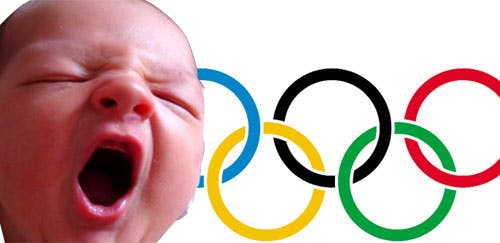Olympic fatigue: fact or myth
Flames general manager Darryl Sutter recently expressed mild concern about the potential dire consequences of having six of his players in contention for roster spots at the 2010 Olympics. He’s especially worried about the possibility of having one of his high-priced Canadian warriors – Jarome Iginla, Robyn Regehr, Dion Phaneuf and Jay Bouwmeester – go down during the upcoming summer camp, which will be held at the building formerly known as the Olympic Saddledome. (Note that Flames properties Olli Jokinen and Miikka Kiprusoff have already emerged unscathed from Finland’s summer get-together).
Otherwise, he’s outwardly gung ho about the whole five-ring circus thing and seems ready to concede on the patriotism angle, a remarkable gesture for a man who would probably like to see the IOC grant permission for rural Alberta to enter its very own team at the Winter Games.
Left unsaid by Sutter but the source of fretting by some Flames fans is the possible negative impact of the toll the gold-chasing will have on the silver Cup-chasing once the National Hockey League schedule resumes. What toll, if any, is there on NHL teams who have plenty of potential Olympians?
Given that this is only the fourth Olympics in which active NHLers have taken part, the sample size is relatively small and a nominal case can be made either way. In 2006, for instance, the Red Wings had a whopping nine players at Torino and Detroit wound up being unceremoniously ousted in the first round of the playoffs by Edmonton, which had only three players at the Olympics (Chris Pronger, Ryan Smyth and Ales Hemsky) and wound up reaching the Stanley Cup final.
Cup champion Carolina also had a relatively modest three Olympians that year, one of whom – goalie Martin Gerber – was acting merely as a gatekeeper by the time the latter round of the 2006 playoffs had rolled around.
But if you go back to 2002, the Red Wings again had nine Olympians – including Brendan Shanahan and Steve Yzerman, who played for gold-winning Canadians – and this time the talent-laden club went on to hoist the shiny silver smokestack three months and change after the Olympic touch was extinguished. A possible mitigating factor in this case is the fact the Games were held on North American soil (Salt Lake City) and that the effects of fatigue may not have been as great as when the Olympics are overseas.
And speaking of jet lag, what about the first NHL-endorsed Olympics – the 1998 Winter Games in Nagano, Japan? Well, there were four teams that sent at least a half-dozen players to Asia that winter (Philadelphia, Pittsburgh, Chicago and Colorado) are none of them had very happy springs.
The Penguins and Avalanche, the No. 2 seeds in the East and West, were upset in first-round series by Montreal and Edmonton, respectively. Philly, which had the most Olympians with nine, was a No. 3 seeded that was ousted by Buffalo. The Blackhawks, despite all that international talent, didn’t make the playoffs at all.
Meanwhile, the Cup-champion Red Wings had only four Olympians in 1998 (Shanahan, Yzerman, Sergei Fedorov and Nicklas Lidstrom) while runners-up Washington has just two – Sergei Gonchar and Calle Johansson.
Make of that what you will.
Recent articles from Jean Lefebvre






